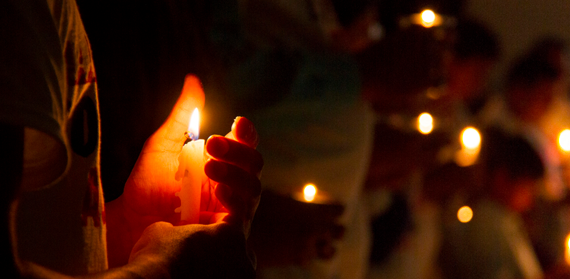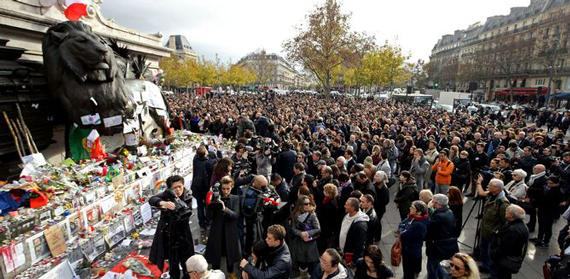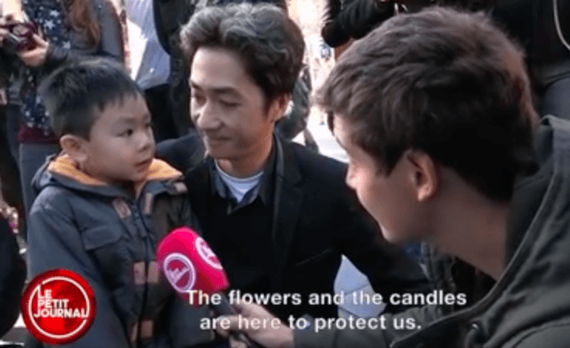Image: Kevin J Beaty/Flickr, CC BY-NC
Guest post by Gavin Brent Sullivan, Centre for Research in Psychology, Behaviour and Achievement
The emotional trauma of the November 13 attack in Paris reaches far beyond those whose lives were directly affected. Both those who live near to where the attacks occurred, and those who identify with the victims from further afield, have experienced fear, concern and shock. Now, the people of Paris must come to terms with what they’ve experienced, and find ways to cope with their losses.
But when the emotions of large numbers of people focus on the same events at the same time, we must consider how the citizens of a city – or even an entire nation – share and experience their emotions as a group.
There is a complex interaction between the emotions that people share with others, and how those emotions are represented as collective experiences of “shock” or “mourning”. Yet these descriptions do somehow capture the very real sense that the atmosphere or emotional climate of a place has changed: this is evident in the reduced number of people on the streets, the knee-jerk reactions to non-threatening events, and the absence of laughter in public spaces.
How people feel tends to be reinforced by, and reflected in, what’s going on in their local environment. As a result, norms quickly develop about what is the right thing to do, or the appropriate way to behave.
Coming together
Some worry that communal emotion, especially of high intensity, can trigger mindless “mob” behaviour, such as stampedes or riots. This is not an entirely baseless concern – in the days after the recent terrorist attacks, an ill-timed round of fireworks caused panic at the Place de la Republique. But on the whole, such worries tend to be misguided. While emotions can run high after a terrorist attack, the typical responses are of sorrow and defiance.
In moments of collective sorrow, people often feel the need to demonstrate the depth of their emotions by placing flowers at relevant sites, gathering in public places, staging candle-lit vigils and engaging in group-reinforcing rituals or activities, such as singing the national anthem. The “minute of silence” – typically observed as a way of memorialising death or great suffering – is another example.
Parisians observe a minute of silence in the Place de la Republique after the November attacks. Steve Parsons/PA Wire
Recent studies show that when citizens of a city engage in these ritualistic events en masse, it creates a sense of togetherness and causes people to identify more closely with others in the group. Research conducted after the 2004 Madrid train bombings found that participating in rituals and demonstrations against war and terrorism which “promote solidarity with positive ideals rather than hatred toward an enemy” fostered a positive emotional climate of hope, solidarity and trust.
It seems that taking part in demonstrations reinforced the belief that the people of Madrid could respond positively and resiliently to collective trauma.
Events in Paris suggest that a similar process is taking place. On the Sunday after the attacks, thousands marched behind a banner which read “Not Afraid”. Many hugged a Muslim man, who stood blindfolded on the streets in an attempt to restore trust. And one remarkable interview featuring a father and son captured how these shared experiences can foster trust and renew hope.
Screenshot from Le Petit Journal’s interview with Angel Le and his six-year-old son, Brandon. Jerome Isaac Rousseau/Facebook
In these ways and more, Parisians are demonstrating their commitment to the value of “fraternité” in the face of adversity. That said, collective efforts to mourn can only go so far toward addressing the trauma caused by such attacks.
Coping with trauma
Based on research conducted in the aftermath of 9/11, only a minority of citizens will go on to develop post-traumatic stress disorder (PTSD) and long-term psychological problems as a result of terrorist attacks. But it’s still crucial that individuals are provided with adequate support, to help them cope with distressing events.
Psychosocial support provided by organisations such as the Red Cross and psychological interventions to provide “debriefing” may not necessarily reduce the risk of developing PTSD. Research suggests that it may even impede the natural coping processes.
This is why some argue that support efforts should draw on the existing “social capital” within communities affected by such overwhelming and distressing events. This means that the resources necessary for recovery should be provided with reference to the bonds that people feel with a place, and the networks of relationships within their community.
Accordingly, the citizens of Paris should support people who are suffering and vulnerable, as well as engaging in collective efforts to cope.
Community spirit
There are further limits to the benefits of collective mourning. Even when the dominant response to atrocities like the Paris attacks is non-violent defiance, solidarity and a desire not to let terrorists “win”, this does not mean that everyone will feel the same way. Emotions are not always contagious, and experiencing solidarity with fellow citizens doesn’t exclude the possibility that people will also feel other, more aggressive, impulses. This is evident from the recent surge in applications to join the French army.
It is also possible that some people will project their anger and hatred towards those they perceive as “outsiders” or minority groups. That’s why it’s crucial for authorities to manage protests and demonstrations with sensitivity: if these events are fuelled by anger, or target minority groups, they will inevitably escalate tensions within the local community and increase the likelihood of further tragic violence.
The citizens of Paris still have a long mourning process in front of them. Feelings are still raw, and have the potential to be shaped by further events. There are likely to be intense emotional peaks at key moments, such as the re-opening of places where people have been killed. Eventually, anniversaries and longer-term decisions – such as whether to dedicate monuments or memorials to the victims – will cause people to reflect on and re-experience feelings of grief and sorrow.
While displays of respect, solidarity and community “spirit” are by no means a cure-all for the lasting social impacts of terrorist attacks, they clearly have a significant role to play. Whatever happens, it’s now more important than ever to ensure that everyone is included in the mourning process. By doing so, Paris will emerge from this tragedy as a stronger, more unified city.
Originally written for ‘The Conversation’.






Comments are disabled